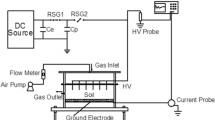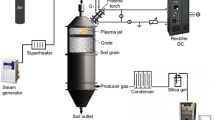Abstract
Petroleum hydrocarbons released to the environment caused by leakage or illegal dumping pose a threat to human health and the natural environment. In this study, the potential of a pulsed corona discharge plasma system for treating petroleum-polluted soils was evaluated. This system removed 76.93 % of the petroleum from the soil in 60 min with an energy efficiency of 0.20 mg/kJ. Furthermore, the energy and degradation efficiencies for the remediation of soil contaminated by single polyaromatic hydrocarbons, such as phenanthrene and pyrene, were also compared, and the results showed that this technology had potential in organic-polluted soil remediation. In addition, the role of water molecules was investigated for their direct involvement in the formation and transportation of active species. The increase of soil moisture to a certain extent clearly benefitted degradation efficiency. Then, treated soils were analyzed by FTIR and GC-MS for proposing the degradation mechanism of petroleum. During the plasma discharging processes, the change of functional group and the detection of small aromatic hydrocarbons indicated that the plasma active species attached petroleum hydrocarbons and degradation occurred. This technique reported herein demonstrated significant potential for the remediation of heavily petroleum-polluted soil, as well as for the treatment of organic-polluted soils.








Similar content being viewed by others
Abbreviations
- PAHs:
-
Polycyclic aromatic hydrocarbons
- AOPs:
-
Advanced oxidation processes
- PCD:
-
Pulsed corona discharge
- PHE:
-
Phenanthrene
- SI:
-
Supporting information
- DC:
-
Direct current
- EE:
-
Energy efficiency
- HPLC:
-
High-performance liquid chromatography
- TOC:
-
Total organic carbon
- GC-MS:
-
Gas chromatography-mass spectrometry
- FTIR:
-
Fourier transform infrared spectroscopy
References
Ayoub K, van Hullebusch ED, Cassir M, Bermond A (2010) Application of advanced oxidation processes for TNT removal: a review. J Hazard Mater 178:10–28
Cadorin BM, Tralli VD, Ceriani E, de Brito Benetoli LO, Marotta E, Ceretta C, Debacher NA, Paradisi C (2015) Treatment of methyl orange by nitrogen non-thermal plasma in a corona reactor: the role of reactive nitrogen species. J Hazard Mater 300:754–764
Cheng M, Zeng G, Huang D, Lai C, Xu P, Zhang C, Liu Y (2016) Hydroxyl radicals based advanced oxidation processes (AOPs) for remediation of soils contaminated with organic compounds: a review. Chem Eng J 284:582–598
Choi H, Lim HN, Kim J, Hwang TM, Kang JW (2002) Transport characteristics of gas phase ozone in unsaturated porous media for in-situ chemical oxidation. J Contam Hydrol 57:81–98
Du C, Shi T, Sun Y, Zhuang X (2008) Decolorization of acid Orange 7 solution by gas-liquid gliding arc discharge plasma. J Hazard Mater 154:1192–1197
Labud V, Garcia C, Hernandez T (2007) Effect of hydrocarbon pollution on the microbial properties of a sandy and a clay soil. Chemosphere 66:1863–1871
Li R, Liu Y, Sun Y, Zhang W, Mu R, Li X, Chen H, Gao P, Xue G, Ognier S (2015) Degradation of p-nitrophenol in soil by dielectric barrier discharge plasma. Water Air Soil Poll 226
Li R, Liu Y, Cheng W, Zhang W, Xue G, Ognier S (2016a) Study on remediation of phenanthrene contaminated soil by pulsed dielectric barrier discharge plasma: the role of active species. Chem Eng J 296:132–140
Li R, Liu YA, Cheng WY, Zhang WJ, Xue G, Ognier S (2016b) Study on remediation of phenanthrene contaminated soil by pulsed dielectric barrier discharge plasma: the role of active species. Chem Eng J 296:132–140
Li X, Cao X, Wu G, Temple T, Coulon F, Sui H (2014) Ozonation of diesel-fuel contaminated sand and the implications for remediation end-points. Chemosphere 109:71–76
Liu P-WG, Whang L-M, Yang M-C, Cheng S-S (2008) Biodegradation of diesel-contaminated soil: a soil column study. J Chin Inst Chem Eng 39:419–428
Lou J, Lu N, Li J, Wang T, Wu Y (2012) Remediation of chloramphenicol-contaminated soil by atmospheric pressure dielectric barrier discharge. Chem Eng J 180:99–105
Lukes P, Appleton AT, Locke BR (2004) Hydrogen peroxide and ozone formation in hybrid gas-liquid electrical discharge reactors. IEEE T Ind Appl 40:60–67
Maddela NR, Burgos R, Kadiyala V, Carrion AR, Bangeppagari M (2016) Removal of petroleum hydrocarbons from crude oil in solid and slurry phase by mixed soil microorganisms isolated from Ecuadorian oil fields. Int Biodeter Biodegr 108:85–90
Magureanu M, Piroi D, Mandache NB, David V, Medvedovici A, Parvulescu VI (2010) Degradation of pharmaceutical compound pentoxifylline in water by non-thermal plasma treatment. Water Res 44:3445–3453
Mu R, Liu Y, Li R, Xue G, Ognier S (2016) Remediation of pyrene-contaminated soil by active species generated from flat-plate dielectric barrier discharge. Chem Eng J 296:356–365
Plaza G, Nalecz-Jawecki G, Ulfig K, Brigmon RL (2005) The application of bioassays as indicators of petroleum-contaminated soil remediation. Chemosphere 59:289–296
Redolfi M, Makhloufi C, Ognier S, Cavadias S (2010) Oxidation of kerosene components in a soil matrix by a dielectric barrier discharge reactor. Process Saf Environ Prot 88:207–212
Sanscartier D, Zeeb B, Koch I, Reimer K (2009) Bioremediation of diesel-contaminated soil by heated and humidified biopile system in cold climates. Cold Reg Sci Technol 55:167–173
Sherwood MK, Cassidy DP (2014) Modified Fenton oxidation of diesel fuel in arctic soils rich in organic matter and iron. Chemosphere 113:56–61
Stasiulaitiene I, Martuzevicius D, Abromaitis V, Tichonovas M, Baltrusaitis J, Brandenburg R, Pawelec A, Schwock A (2016) Comparative life cycle assessment of plasma-based and traditional exhaust gas treatment technologies. J Clean Prod 112:1804–1812
Wang T, Lu N, Li J, Wu Y, Su Y (2011) Enhanced degradation of p-nitrophenol in soil in a pulsed discharge plasma-catalytic system. J Hazard Mater 195:276–280
Wang TC, Lu N, Li J, Wu Y (2010) Evaluation of the potential of pentachlorophenol degradation in soil by pulsed corona discharge plasma from soil characteristics. Environ Sci Technol 44:3105–3110
Wang TC, Qu G, Li J, Liang D (2014a) Evaluation of the potential of soil remediation by direct multi-channel pulsed corona discharge in soil. J Hazard Mater 264:169–175
Wang TC, Qu G, Li J, Lu N (2014b) Transport characteristics of gas phase ozone in soil during soil remediation by pulsed discharge plasma. Vacuum 101:86–91
Yen C-H, Chen K-F, Kao C-M, Liang S-H, Chen T-Y (2011) Application of persulfate to remediate petroleum hydrocarbon-contaminated soil: feasibility and comparison with common oxidants. J Hazard Mater 186:2097–2102
Acknowledgments
This work was completed by the financial support of the National Natural Science Foundation of China (No. 51578122), the program for New Century Excellent Talents in University (NCET-12-0826), Shanghai Pujiang Program, the Fundamental Research funds for Central Universities (CUSF-DH-D-2015041), and China Scholarship Council. All the financial supports are gratefully acknowledged.
Author information
Authors and Affiliations
Corresponding author
Additional information
Responsible editor: Bingcai Pan
Electronic supplementary material
ESM 1
(DOCX 8 kb)
Rights and permissions
About this article
Cite this article
Li, R., Liu, Y., Mu, R. et al. Evaluation of pulsed corona discharge plasma for the treatment of petroleum-contaminated soil. Environ Sci Pollut Res 24, 1450–1458 (2017). https://doi.org/10.1007/s11356-016-7929-x
Received:
Accepted:
Published:
Issue Date:
DOI: https://doi.org/10.1007/s11356-016-7929-x




